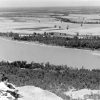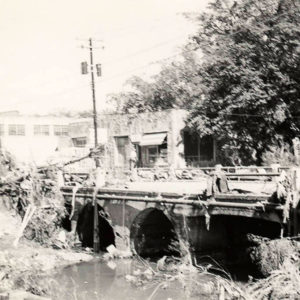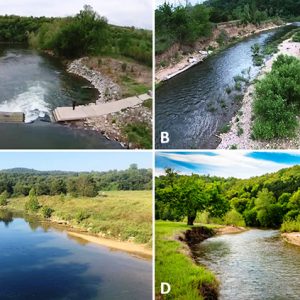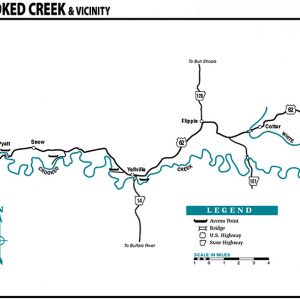calsfoundation@cals.org
Crooked Creek (Watershed)
Crooked Creek is a 129 km (80 mi.) Ozark highland White River tributary in Boone, Marion, and Newton counties of northern Arkansas. The stream’s headwaters (36°06′47″N, 93°02′19″W) begin at Sulphur Spring (Newton County) on the north side of Sulphur Mountain just south of Harrison (Boone County) and east of Marble Falls (Newton County), the location of Dogpatch USA, and flow north, passing under Arkansas Highway 206 just west of Elmwood (Boone County). The stream continues north, traveling parallel (eastward) to Arkansas Highway 7, passing through the southeastern part of Harrison and under U.S. Highway 65. The stream immediately turns eastward, beginning a long series of meanders by which it gained its name. Crooked Creek then turns southeast, passing the communities of Pyatt (Marion County) and Summit (Marion County) and under U.S. Highway 65. It continues to flow eastward roughly paralleling U.S. 65 (south) and crossing under Arkansas Highway 14 south of Yellville (Marion County). It continues farther eastward and goes under Arkansas Highway 101 near Rea Valley until entering the confluence of the White River (36°10′15″N 93°06′55″W) just south of Buford Station below the town of Cotter (Baxter County).
The stream flows through a variety of habitats—including oak-hickory (Quercus–Carya) hardwood forests, cedar glades, and pastureland—until it converges with the White River. The creek flows through rolling pastureland, cedar glades, bluffs, and tree-lined banks. Other major trees of the watershed include willow (Salix), hackberry (Celtis occidentalis), pawpaw (Asimina triloba), catalpa (Scopoli), and black walnut (Juglans nigra).
In terms of larger mammalian fauna, the creek provides ample habitat for mink (Mustela vison), beaver (Castor canadensis), muskrat (Ondatra zibethicus), white-tailed deer (Odocoileus virginianus), and river otter (Lontra canadensis). Avian fauna include belted kingfishers (Megaceryle alcyon), ospreys (Pandion haliaetus), bald eagles (Haliaeetus leucocephalus), wood ducks (Aix sponsa), and various herons (Ardeidae). Reptiles (especially water snakes, Nerodia spp.) and aquatic turtles (Chelydra, Trachemys, Pseudemys, Graptemys, and Apalone spp.) occur in and around the creek, as do frogs (Acris and Rana spp.). The fish fauna is diverse; a study published in 2011 revealed a total of sixty-five species of fishes distributed among fourteen families.
The stream bed is composed primarily of limestone boulders, bedrock, gravel, and sand. The stream rarely exceeds more than 24 m (80 ft.) in width and is characterized by shallow rocky pools separated by swift, gravelly riffles. Water quality is usually good, with numerous spring-fed clear and cool influences. In most regions, the gradient is not particularly steep, and water flow is usually mild to moderate. However, the creek does support a large watershed, and flash-flooding from heavy rains can turn it very quickly into a dangerous, raging torrent.
The creek is renowned for its trophy (blue ribbon) smallmouth bass (Micropterus dolomieu) fishing, but it is also popular among visitors seeking a swimming hole, a walking trail, or a canoe float trip. In fact, the best places to float are between Pyatt and Yellville. The water level in the creek depends entirely on rainfall, and normal water levels typically mean it is floatable from early spring to early summer. However, east of Yellville, the stream is intermittent and often dries up almost completely in the summer and early fall.
In 2012, the Arkansas Game and Fish Commission (AGFC) designated a 35 km (22 mi.) strip of water as the Crooked Creek Water Trail, which covers the stream from the Lower Pyatt Access to Yellville. Most importantly, tourists should be fully aware that nearly all property along Crooked Creek is privately owned and marked by fences, “no trespassing” signs, or purple paint on fence posts or trees.
The Fred Berry Conservation Education Center of the AGFC south of Yellville on Crooked Creek covers 421 acres along a 4.4 km (2.8 mi.) bend of the creek. The center includes interpretive trails, outdoor and indoor learning areas, and access to the creek.
Builders have found Crooked Creek to be a very good source for gravel and sand. Due to rapid population growth in and around the Yellville and Mountain Home (Baxter County) areas, with related construction in the Ozarks, pressure for these materials has become high. Therefore, large-scale gravel mining operations have become a serious threat to the water quality of the stream. In addition, Crooked Creek drains a primarily rural area, and the effluent (waste material) from the cities of Harrison and Yellville has been reported to affect the stream physicochemically. Therefore, an intensive effort was made by conservationists to have it placed on the Extraordinary Resource Waterbody list of the state of Arkansas, but that effort failed in 1997. Its inclusion would have outlawed gravel mining within the banks of the creek. However, some laws in place since that time have greatly restricted where and when gravel may be mined and require a reclamation plan. The AGFC promised to work closely with regulatory agencies to ensure that miners comply with these laws to lessen the effects of their operations. Other human activities such as confined animal production (particularly poultry and hog farms), land clearing, and road building also have the potential to harm the stream. In response, an active group of individuals and clubs (the Crooked Creek Coalition) have dedicated themselves to the conservation and protection of Crooked Creek.
Interestingly, some research on fish parasites has been done on Crooked Creek. A trematode parasite called Clinostomum marginatum can be a nuisance for those who fish for smallmouth bass, as it commonly causes “yellow grub” in some of their catches from this creek. Bass from the creek have some of the largest population densities of the metacercarial stage of this trematode. The parasite encysts on fins, gills, and internal organs of the hosts and appears as a yellow nodule; however, as long as the fish are cleaned and cooked properly, the parasite is not harmful to humans. Some acanthocephalan (spiny-headed worm) parasites have also been reported from some fishes from Crooked Creek, including green sunfish (Lepomis cyanellus), Ozark bass (Ambloplites constellatus), and northern hogsuckers (Hypentelium nigricans).
For additional information:
Bowden, Bill. “Harrison Council to Decide on Creek’s Restoration Plan.” Arkansas Democrat-Gazette, October 18, 2021, pp. 1B, 2B. Online at https://www.arkansasonline.com/news/2021/oct/18/removing-dam-would-do-away-with-lake-harrison/ (accessed October 18, 2021).
———. “Plan to Remove Lake and Restore Creek Hits Snag.” Arkansas Democrat-Gazette, December 28, 2023, pp. 1B, 3B. Online at https://www.arkansasonline.com/news/2023/dec/28/lake-harrison-dam-removal-project-on-hold-so/ (accessed December 28, 2023).
Brown, Arthur V., M. M. Lytle, and K. B. Brown. “Impacts of Gravel Mining on Gravel Bed Streams.” Transactions of the American Fisheries Society 127 (1998): 979‒994.
Cashner, Robert C. “A Survey of the Fishes of the Cold Tailwaters of the White River in Northwestern Arkansas, and a Comparison of the White River with Selected Warm-Water Streams.” MS thesis, University of Arkansas, 1967.
Crooked Creek Water Trail. Arkansas Game and Fish Commission. https://www.agfc.com/en/explore-outdoors/wildlife-viewing/water-trails/crooked-creek-water-trail/ (accessed June 29, 2020).
Daly, James J., Bruce DeYoung, Terry Hostetler, and Randal S. Keller. “Distribution of Clinostomum marginatum (yellow grub) Metacercaria in Smallmouth Bass Populations from Crooked Creek in Northern Arkansas.” Journal of the Arkansas Academy of Science 56 (2002): 42‒46. Online at https://scholarworks.uark.edu/jaas/vol56/iss1/8/ (accessed June 29, 2020).
Drope, P. B. “A Physiochemical Survey of Crooked Creek in North Arkansas.” MS thesis, University of Arkansas for Medical Sciences, 1997.
Fred Berry Conservation Education Center on Crooked Creek. Arkansas Game and Fish Commission. https://www.agfc.com/en/explore-outdoors/nature-and-education-centers/fbcec/ (accessed June 29, 2020).
McAllister, Chris T., and Henry W. Robison. “More Host Records for Acanthocephalan Parasites from Arkansas Fishes (Aphredoderidae, Catostomidae, Centrarchidae, Cyprinidae, Esocidae, Percidae).” Journal of the Arkansas Academy of Science 73 (2019). Online at https://scholarworks.uark.edu/jaas/vol73/iss1/29/ (accessed June 29, 2020).
Mountain Home/Bull Shoals Area, Fishing the Arkansas Ozarks, America’s Secret Fishing Hole. http://www.ozarkmtns.com/fishing/fisheries/crook.htm (accessed June 29, 2020).
Robison, Henry W., Chris T. McAllister, and Kenneth E. Shirley. “The Fishes of Crooked Creek (White River Drainage) in Northcentral Arkansas, with New Records and a List of Species.” Journal of the Arkansas Academy of Science 65 (2011): 111‒116. Online at http://scholarworks.uark.edu/jaas/vol65/iss1/16 (accessed June 29, 2020).
Southwest Paddler. Crooked Creek. http://www.southwestpaddler.com/docs/whitear21.html (accessed June 29, 2020).
Chris T. McAllister
Eastern Oklahoma State College








Comments
No comments on this entry yet.